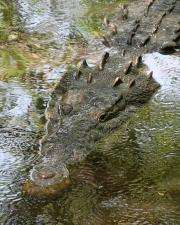Crocodiles ride ocean currents to travel the high seas

University of Queensland ecologists have unlocked the mystery of how salt-water crocodiles cross large stretches of the sea despite being poor swimmers - they like to surf.
Dr Hamish Campbell, from UQ's School of Biological Sciences, together with colleagues from Australia Zoo and Queensland Parks and Wildlife Service, found, like a surfer catching a wave, the crocodiles ride ocean currents to cross large areas of open sea and populate many South Pacific islands.
“Although it spends most of its life in salt-water, it cannot be considered a marine reptile in the same class as a turtle, as it relies upon the terrestrial environment for food and water,” Dr Campbell said.
“Many anecdotal accounts exist of large crocodiles being sighted far out to sea, but this is the first study to show - using underwater acoustic tags and satellite tracking - that estuarine crocodiles ride surface currents during long distance travel, which would enable them to travel between one oceanic island and another.”
The study, published in the British Ecological Society's Journal of Animal Ecology, involved tagging 27 adult crocodiles in the remote Kennedy River in North Queensland with sonar transmitters and used underwater receivers to track their every move over 12 months.
Dr Campbell said they found both male and female adult crocodiles undertook long-distance journeys, regularly travelling more than 50 km from a home area to the river mouth and beyond into open sea.
“The data showed that crocodiles always began long-distance travel within an hour of the tide changing, allowing them to go with the flow, and that they halted their journeys by hauling out on to the river bank when the tide was against them,” he said.
He said one satellite-tagged crocodile - a 3.84 metre-long male - left the Kennedy River and travelled 590 km over 25 days down the west coast of Cape York Peninsula timing its journey to coincide with a seasonal current system that develops in the Gulf of Carpentaria.
A second crocodile - a 4.84 metre-long male - travelled more than 411 km in only 20 days from the east coast of Cape York Peninsula through the Torres Straits to the Wenlock river on the west coast of Cape York. The Torres Straits is notorious for strong water currents, and when the crocodile arrived the currents were moving opposite to its direction of travel. It waited in a sheltered bay for four days and only passed through the Straits when the currents switched to favour the crocodiles journey.
Dr Campbell said the results explained why, despite occupying such a large range, species diversification has not occurred.
“The estuarine crocodile exists as island populations throughout the Indian and Pacific ocean, and because only a single species of salt-water living crocodile exists across this vast area, regular mixing between the island populations probably occurs,” he said.
“It is unlikely that crocodiles swim across vast tracts of ocean, but they can survive for long periods in salt-water without the need for eating or drinking.
“By only travelling when surface currents were favourable, individuals would be able to move long distance by sea.
“This not only helps to explains how estuarine crocodiles move between oceanic islands, but also contributes to the theory that crocodilians have crossed major marine barriers during their evolutionary past.”
Provided by University of Queensland
















